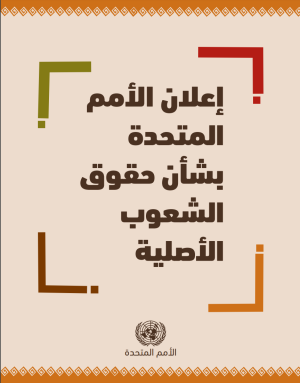UNDRIP

The United Nations Declaration on the Rights of Indigenous Peoples was adopted by the UN General Assembly on Thursday, 13 September 2007 with 144 votes in favor. There were also 11 abstentions and 34 non-voting states, with four settler colonial states initially voting against the Declaration: The United States, Canada, Australia, and New Zealand.
The declaration consists of a preamble listing 24 notes (emphasizing, recognizing, encouraging), followed by 46 articles outlining Indigenous rights.
As summarized by the United Nations:
Today the Declaration is the most comprehensive international instrument on the rights of Indigenous Peoples. It establishes a universal framework of minimum standards for the survival, dignity and well-being of the Indigenous Peoples of the world and it elaborates on existing human rights standards and fundamental freedoms as they apply to the specific situation of Indigenous Peoples.[1]
The Preamble welcomes the organization of Indigenous Peoples to end oppression and discrimination, and "is convinced that control by indigenous peoples over developments affecting them and their lands, territories and resources will enable them" to fulfil their rights. Recognizing the importance of "respect for indigenous knowledge, cultures and traditional practices" for "proper management of the environment", the preamble also emphasizes "the contribution of the demilitarization of the lands and territories of indigenous peoples to peace, economic and social progress."
Just Transition
The UNDRIP establishes an international legal framework centering Indigenous Rights essential to the just transition.
UNDRIP clearly enshrines the international legal right of Indigenous Peoples to:
1) Have control over their land, territories, and resources (Preamble);
2) Conserve and protect the environment and the productive capacity of their lands, territories, and resources (Article 29);
3) Strengthen their relationship with their land to uphold responsibilities to future generations (Article 25);
4) Receive legal recognition and protection from states respecting Indigenous land tenure systems and rights to traditional land, territories, and resources (Article 26);
5) Restitution of lands, territories, and resources taken, occupied, used or damaged without free, prior and informed consent (Article 28);
A growing body of scientific evidence verifies that upholding these rights is the most effective way to prevent deforestation across the planet.[2] Hundreds of studies on the effectiveness of Native land reclamation in the Kawsak Sacha (Amazon Rainforest) have shown that restoring Indigenous Sovereignty therein has prevented billions of tons of carbon emissions.[3][4]
Full Text
UN Official:
عربي | English | Español | Français | 汉语 | Русский
Unofficial:
Arawak | Aucan | Aymara | Bahasa/Indonesian | Belarusian | Bisaya | Bodo (Boro) | Carib | Cha'palaa | Catalan | Crimean Tatar | Degar | Dutch | Danish | Finnish | German | Greek | Greenlandic | Guaraní | Hindi | Ilokano | Innu | Italian | Japanese | Karaim | Karelian | Khmer | Kituba | Kuna | Kwéyòl | Komi | Lingala | Livvi-Karelian | Malay | Maori | Maya | Mapuche | Miskito | Mohawk | Náhuatl | Nanai | Norwegian | Nepali | Persian | Pilipino | Polish | Portugues | Quechua | Sámi (North) | Sámi (Inari) | Sámi (Skolt) | Trio | Thai | Turkish | Ukrainian | Veps | Wajana | Wichi
Sources
- ↑ https://social.desa.un.org/issues/indigenous-peoples/united-nations-declaration-on-the-rights-of-indigenous-peoples
- ↑ https://truthout.org/articles/un-report-says-indigenous-sovereignty-could-save-the-planet/
- ↑ https://www.yesmagazine.org/social-justice/2014/07/29/indigenous-land-management-effective-combating-climate-change
- ↑ https://branchoutnow.org/the-carbon-market-shell-game/